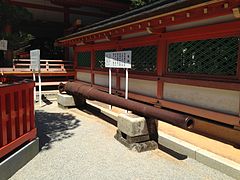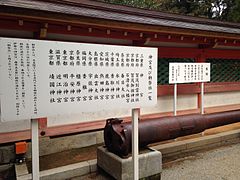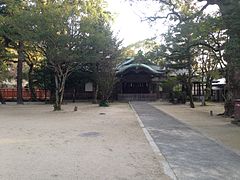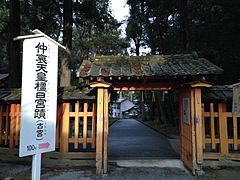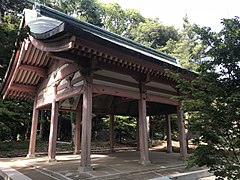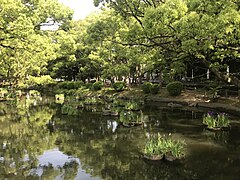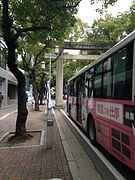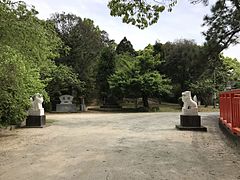User:Immanuelle/Kashii-gū
| This is not a Wikipedia article: It is one user's draft page that they are
working on. It may be incomplete and/or unreliable. This page was last edited by Auntof6 (talk | contribs) 5 months ago. |
This article may be expanded with text translated from the corresponding article in French. Click [show] for important translation instructions.
|
This article may be expanded with text translated from the corresponding article in Japanese. Click [show] for important translation instructions. Content in this edit is translated from the existing Japanese Wikipedia article at [[:ja:香椎宮]]; see its history for attribution.{{Translated|ja|香椎宮}} to the talk page. |
| Immanuelle/Kashii-gū | |
|---|---|
 shrine | |
| Religion | |
| Deity | Emperor Chūai Empress Jingū |
| Location | |
| Geographic coordinates | https://geohack.toolforge.org/geohack.php?pagename=Kashii-g%C5%AB¶ms=33_39_13_N_130_27_10_E_region:JP-40_type:landmark_source:kolossus-dewiki |
| Architecture | |
| Architectural type | kashii-zukuri |
| The English used in this user page may not be easy for everybody to understand. You can help Wikipedia by reading Wikipedia:How to write Simple English pages, then simplifying the page. |
Kashii-gū (香椎宮) is a Shinto shrine in Higashi-ku, Fukuoka, Japan. It worships Emperor Chūai and Empress Jingū.[1]
It is one of the Three Great Shrines of Northern Kyushu, alongside Usa Jingū, and Sumiyoshi Shrine.[2]: 19
It was formerly in the countryside in a dense forest of about three hectares and now in the suburbs of the city of Fukuoka in Japan. There are venerated Emperor Chūai and his wife Jingū, whose son Ōjin is the fifteenth emperor of Japan, as well as the Sumiyoshi sanjin , sea deities..[3][1] As Emperor Chūai found his final resting place here, older texts use the term Kashii-byō (香椎廟, " Kashii courtyard ", " Kashii mausoleum ").[3]
Since the Nara period, the shrine has been part of the small group of shrines called chokusaisha which on certain specific occasions receive the envoys (勅使, Chokushi) of the tennō . As at the Usa Hachiman-gū shrine (northeast of Kyūshū ), this happens every ten years in Kashii. The 800m long staircase which leads to the sanctuary is lined with camphor trees .
The structure, called Kashii style (香椎造, Kashii-zukuri),[4] of the main building, (the honden ) — whose current appearance dates back to the last reconstruction in 1801 — can only be found here. The building is divided into three parts with hinged doors and a roof with many forks ( chigi ).[5][6][1]
For many generations, the priesthood was reserved for four families who took turns every four years in the exercise of their functions.
Until the middle of the 20th century there were in the vicinity a number of Buddhist temples of the Shingon school which, as a result of the law of " separation of Shinto and Buddhism » ( shinbutsu bunri ,神仏分離) of 1868 were destroyed. Today, the only remaining witness to this past where Shintoism and Buddhism were mixed ( shinbutsu shūgō ,神仏習合), is a small temple of the divinity Benzaiten .
Historical Background
[change | change source]Empress Jingu founded the Kashii gu Shrine around the year 200 AD to honor Emperor Chuai, her late husband, who is said to have passed away at this location. The shrine serves as a memorial for not Empress Jingu but their son, Emperor Ojin commemorating three important figures from ancient Japanese tales. While historical records do not definitively confirm their existence the shrine has maintained a connection to Japans lineage.[6][7][1]
On the site are other small shrines dedicated to the deities Inari, Takeuchi Sukune, etc. According to tradition, the legendary Jingū had a Kashii no miya shrine (橿日宮) built here in 200, when Chūai died in battle against the Kumaso people. There would have been an ancient sanctuary in the vicinity of this one but there is no historical mention of it before the year 723 .[3][1]
Records indicate that the shrine was officially established in 724 following an oracle associated with Empress Jingû. Documentation from 728 further confirms the shrines existence during that era emphasizing its importance since its inception. Kashiigu has been acknowledged as a shrine evidenced by visits from imperial messengers every ten years—a tradition upheld throughout centuries.[7]
A notable tradition that highlights this bond is the visitation by an envoy to Kashii gu Shrine once every ten years. This custom places Kashii gu among a group of 17 shrines across Japan that receive esteemed visits. Over time 138 imperial envoys have visited the shrine. The Sandō path leading to the shrine is called "Imperial Envoy Road " and it is lined with 165 camphor trees symbolizing unity among present municipalities, within the prefecture.[6] This is because the shrine is a Chokusaisha.[8][9][10]
Facilities
[change | change source]Main hall
[change | change source]The main hall of Kashii gu showcases the style known as Kashii style (香椎造, Kashii-zukuri), a design specific, to this shrine. Constructed in 1801 under the patronage of Nagayori Kuroda, the lord of Chikuzen Province the current structure is believed to be a scaled down version of its form. Despite this the shrine continues to exude a sense of spaciousness and spiritual significance.[6][1][5]
There is a sacred Shinboku tree Ayasugi, a Japanese cedar tree whose seed was buried in the ground by Empress Jingu herself.[6][7]
The gateway to the area is marked by the Romon gate leading to the core shrine complex. This complex comprises the Honden, Haiden, and Heiden all interconnected and reconstructed in 1801. The architectural style of the shrine, known as "Kashii style (香椎造, Kashii-zukuri)" is distinct and specific to Kashiigu Shrine.[7][1]
In addition, to its hall, Kashii gu houses many smaller Shrines or Setsumatsusha honoring various deities. Among them is a shrine that worships Takenouchi no Sukune, a figure known for his longevity spanning five imperial reigns. .[6][11]
Spring of youth
[change | change source]The Furôsui Spring (water of youth)[1] lies 500 meters northeast of the shrine within an area. According to legend a Takenouchi no Sukune who drank from this spring lived for over three centuries. The water, from this spring is renowned for its purity. Is annually offered to the family during New Years festivities. Visitors can also sample this water at the shrine believed to possess life prolonging qualities.[7][1][6][11] Until the Meiji Restoration there was an annual event of delivering water from it to the Emperor of Japan in Kyoto.[3] Takenouchi no Sukune is said to have lived for centuries from drinking this water[11]. The well is recognized as one of Japans 100 springs.[6][11]
The shrines grounds cover an area 400x200 meters with the former being the x axis or west to east, and the latter or 200 meters being the Y axis of north to south. The western part of the precinct includes an approach spanning 120 meters. Moreover there is a pathway stretching one kilometer on the west side of the JR railway station lined with camphor trees leading to the shrines entrance.[7]
There is a garden nearby full of Iris flowers.[7]
Gallery
[change | change source]-
The Honden or main shrine (Important Cultural Property)
-
Back view of Honden
-
Cannon of Settsu
-
Cannon of Settsu
-
Chokushikan Hall
-
Chokushikan Hall
-
Chokushikan Hall
-
Chozuya and Emado Hall
-
Direction Sign
-
Drum in Kaguraden Hall
-
Ema on hamaya
-
Emado Hall
-
Forest near Terrapin Pond
-
Furosui Holy Spring
-
Furosui Holy Spring
-
Furou spring water well
-
Furousui
-
Gate and fence
-
Guardian lion and stele
-
Guardian Lion
-
Guardian lions
-
Guardian lions
-
Haiden and honden
-
Haiden and Nakamon gate
-
Haiden
-
Haiden
-
Haiden
-
Haiden
-
Honden
-
Honden
-
Honden
-
Honden
-
Hydrangea macrophylla
-
Iris Pond
-
Torii on Kashii-Sando Avenue
-
Torii on Kashii-Sando Avenue
-
Torii
-
Torii on Kashii Sando Avenue
-
Trees planted by royalty
-
View from Romon gate
-
View in front of shrine
-
View in Kashii Shrine
-
View in Kashii Shrine
-
View near Kashii Shrine
-
View of Emado Hall
-
View of Furosui Holy Spring
-
View of Hayatsuji Shrine
-
View of Iris Pond
-
View of Site of former shrine
-
View of site of former shrine
-
View of stele in Tongu Shrine
-
View of Terrapin Pond
-
View of torii in front of Romon Gate
-
View of torii near Former Kashii Shrine
-
View on Kabuto Mound
-
Warship Kashii Memorial
-
Man'yōshū Monument
See also
[change | change source]References
[change | change source]- ↑ 1.0 1.1 1.2 1.3 1.4 1.5 1.6 1.7 1.8 "Kashii-gu Shrine". VISIT FUKUOKA -Fukuoka Prefecture Official Travel Guide. Retrieved 2024-03-28.
- ↑ Grapard, Allan G.; Rambelli, Fabio (2016-02-25). Mountain Mandalas: Shugendo in Kyushu (Illustrated edition ed.). London New York (N. Y.): Bloomsbury Academic. ISBN 978-1-4742-4900-3.
{{cite book}}:|edition=has extra text (help) - ↑ 3.0 3.1 3.2 3.3 "HISTORY". www.ip.kyusan-u.ac.jp. Retrieved 2024-03-28.
- ↑ "Kashii-zukuri (香椎造)". www.aisf.or.jp. Retrieved 19 novembre 2019.
{{cite web}}: Check date values in:|access-date=(help). - ↑ 5.0 5.1 "HONDEN". www.ip.kyusan-u.ac.jp. Retrieved 2024-03-28.
- ↑ 6.0 6.1 6.2 6.3 6.4 6.5 6.6 6.7 now, fukuoka (2014-05-28). "Kashii-gu: A Shrine with Close Ties to the Imperial Court". Fukuoka Now. Retrieved 2024-03-28.
- ↑ 7.0 7.1 7.2 7.3 7.4 7.5 7.6 "Kashiigu shrine (Fukuoka city, Fukuoka Prefecture) - Let's travel around Japan!". Let's travel around Japan. Retrieved 2024-03-28.
- ↑ An Encyclopedia of Shinto: Norman Havens, Nobutaka Inoue. Institute for Japanese Culture and Classics Kokugakuin University, 2006. Retrieved 1 January 2014.
- ↑ "Shinto Jiten (Dictionary of Shinto: 神道事典): Kokugakuin Daigaku Nihon Bunka Kenkyujo (国学院大学日本文化研究所), ed. Tokyo: Kokubundo, 1994". Retrieved 1 January 2014.
- ↑ "Jinja jiten (神社辞典)/ Shirai Eiji ; Toki Masanori hen, 1997". Retrieved 1 January 2014.
- ↑ 11.0 11.1 11.2 11.3 "FUROSUI". www.ip.kyusan-u.ac.jp. Retrieved 2024-03-28.
- Chokusaisha
- Kokushi Genzaisha
- Beppyo shrines
- Kanpei-taisha
- Shinto shrines in Fukuoka Prefecture
- Articles containing Japanese-language text
- Coordinates on Wikidata
- Shinto shrines
- Wikipedia drafts
- Draft articles
- Mausoleums in Japan
- Kanpei Taisha
- Kokushi genzaisha
- Kanpei-taisya
- Edo period architecture
- Springs of Japan
- Shinto shrines in Japan
- Shrines dedicated to empress Jingū
- Top 100 Famous Waters
- Important cultural property (buildings)
- Ancient Japan-Korea relations simple:User:Immanuelle/Kashii-gū




